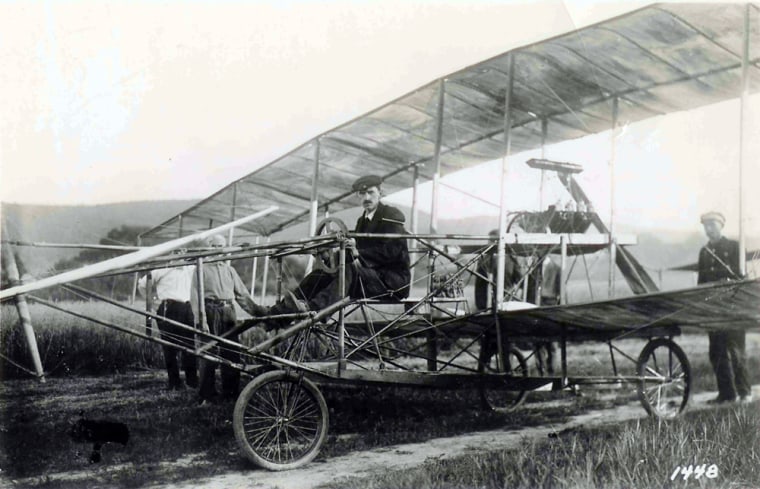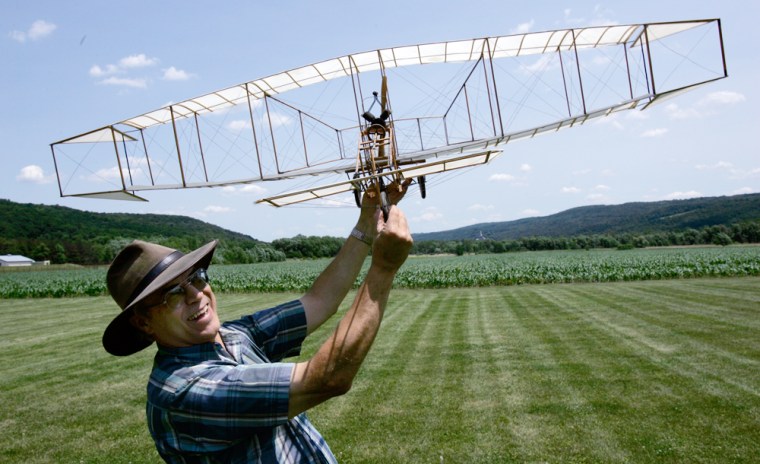On a steamy Fourth of July evening a century ago, a wood-and-fabric biplane lifted off from Stony Brook Farm and stayed airborne for almost a mile in a stupendous triumph over gravity witnessed by more than 2,000 people.
It was the first pre-announced public flight in America, the first heavier-than-air flying machine outside Europe to officially remain aloft and under control for a kilometer or more. And it helped elevate pilot Glenn H. Curtiss to national hero status — to the dismay of Orville and Wilbur Wright.
The Wrights’ epochal flight over the dunes at Kitty Hawk, N.C., in 1903 had been cloaked in secrecy. Fearing their ideas would be stolen, the Ohio brothers spent much of the next five years out of the public eye as they tried to lock down patents to secure commercial control over the nascent aerial age. Historians say their first flights were spotted only by five passers-by, and before Curtiss made his mark, fewer than 100 Americans had glimpsed the marvel of aviation.
In Europe, by contrast, “people were showing up by the hundreds and even the thousands” to watch pioneers of flying, said Tom Crouch, a Wright brothers biographer and senior curator of aeronautics at the Smithsonian Institution’s National Air and Space Museum.
Curtiss, a motorcycle builder who set a land speed record of 136 mph in January 1907, accepted an invitation that summer to supply powerful, lightweight engines to a five-member Aerial Experiment Association led by inventor Alexander Graham Bell.
Within a year, the team invited the Aero Club of America to send representatives to Curtiss’ tiny hometown of Hammondsport in western New York to observe his attempt to fly its insectlike June Bug plane across bucolic Pleasant Valley on Independence Day 1908.
His first try when the overcast skies finally cleared late in the day could have ended in disaster. The June Bug, which was supposed to rise only a few dozen feet, shot more than 200 feet (60 meters) above the crowd before Curtiss cut the 8-cylinder engine and glided back down without causing damage. The tail section had been wrongly angled.
On his second attempt at around 7:30 p.m., the plane with its crackling, smoky engine bobbed unevenly about 10 to 20 feet (3 to 6 meters) above vineyards, potato fields and a racetrack. It flew for 5,090 feet (1.55 kilometers) in 1 minute, 42.5 seconds before touching down just short of the village limits.
Crowded on the grassy hillsides, onlookers roared out their delight, honked their horse-and-buggy horns and swarmed down into the fields and adjacent pastures to greet the intense but taciturn aviator.

“This thing was wobbling back and forth and up and down, but it kept going and going and going as everybody got more and more excited,” said Trafford Doherty, director of the Glenn H. Curtiss Museum and grandson of a Curtiss test pilot.
Looking out across the same crop field in Pleasant Valley, with tree-topped ridges on each side and a sliver of Keuka Lake barely visible on the horizon, Doherty noted that little has changed about the site that locals hope to have listed on the National Register of Historic Places.
At a picnic and music gala on Saturday, a model club will fly a quarter-scale, remote-controlled model of the June Bug above the valley. A full-scale reproduction sits in the nearby Curtiss museum, which is packed with aircraft, motorbikes and memorabilia and draws 30,000 visitors a year.
Soon after the June Bug success, the Wrights went to court to try to keep Curtiss planes off the market in a labyrinthine dispute only set aside with America’s entry into World War I in 1917.
“I’m well aware of their genius, but I think the Wright brothers also hampered the development of American aviation through patents and court battles,” Doherty said.
Crouch thinks too much is made of the rivalry.
“The Wright brothers may have driven a few small potatoes out of the field, but they certainly didn’t have a big impact on Glenn Curtiss,” Crouch said. “He’s a much better businessman than they are.”
Curtiss himself racked up dozens of patents for landing gear, ailerons and other innovations still present in aircraft today. He developed the first practical seaplane in 1911 and the flying boat in 1912, earning renown as “the father of naval aviation.” From 1916 to 1918, he turned Buffalo into the airplane manufacturing hub of America.
He rolled out success after success: The nation’s first open flying school. The first water-cooled engines, to extend air travel. A Curtiss-designed behemoth vanquished the Atlantic in 1919, only stopping on the Azores, 17 days before Britons John Alcock and Arthur Brown made the first nonstop crossing.
“You get told in grade school that the Wright brothers invented the airplane, but it’s a great simplification,” Doherty said. “This was a science that was developing all over the world.”
The Wrights were undeniably first, but others moved the technology forward, he added. “Now, at last, you’re starting to see a more evenhanded attitude toward Curtiss.”
